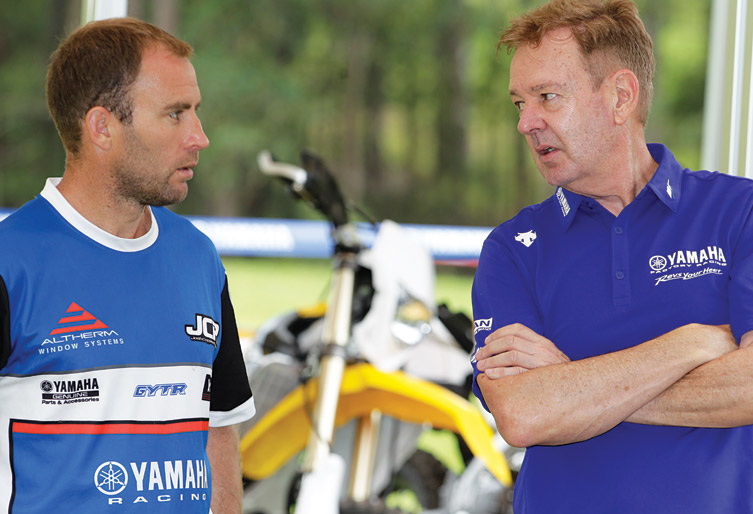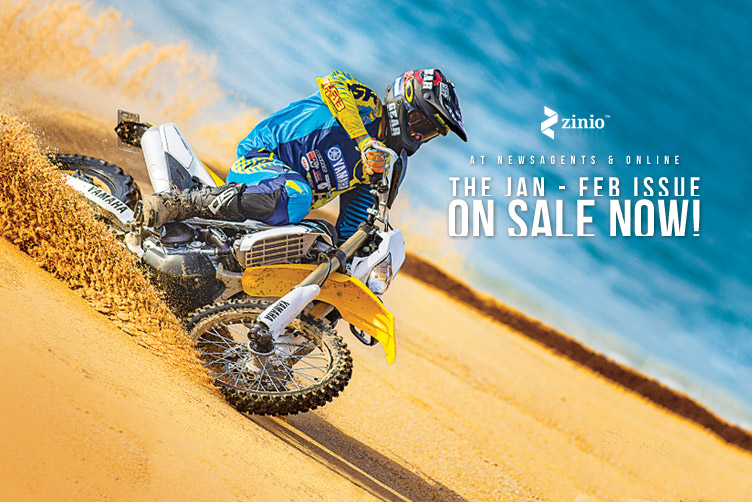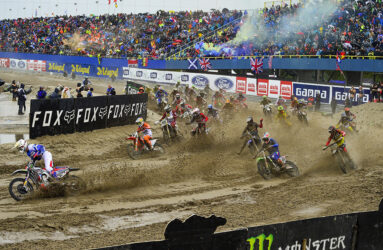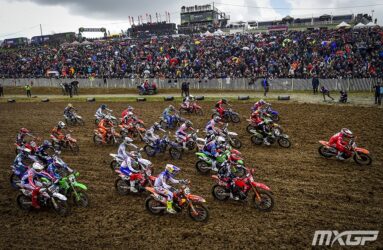2016 WR450F: Developed For Anzacs
It may be a few years overdue, but Yamaha’s all-new 2016 WR450F has been worth the wait. With the sort of versatility that’ll attract both trailriders and racers, this YZ450F-inspired enduro machine looks set to reclaim its mantle as Australia’s biggest-selling dirt bike.
When Yamaha last significantly updated its WR450F back in 2012, it came with up-specced suspension, frame and bodywork, and its ageing five-valve engine got fuel injection for the first time. But that machine felt like a bit of a cobbled-together job; a distraction designed to prevent Yamaphiles from jumping ship, rather than a genuine attempt to improve the breed. From 2012 to 2015, the WR450F remained a solid all-round trailbike, but it was never comfortable at race pace. It simply wasn’t light or agile enough to keep pace with the European brands’ constantly updated 450s. And as the WR450F’s lack of versatility became increasingly apparent, its popularity waned.
So, is Yamaha’s 2016-model WR450F any different? Yes, entirely different. Based on the all-conquering YZ450F, the completely overhauled 2016 WR450F is the machine the other manufacturers were hoping would never materialise; a lightweight, agile, hard-nosed, high-performance enduro weapon, coupled with Yamaha’s notorious reliability.
But has Yamaha got the race/trail mix right with this new-generation machine? And how well has its MX-bike DNA been adapted for off-road use? To answer those questions, we hit up the two guys primarily responsible for the development of Yamaha’s 2016 WR450F for the Australian and New Zealand markets, Peter Payne and Josh Coppins. Payne is now YMA’s Brand Development Manager and has been involved with the WR-F’s development since the first WR400F in 1998, while Coppins is a 15-season veteran of the Motocross World Championship who now works closely with Yamaha in Japan, Australia and New Zealand in his role as both a team manager and development rider.
We sat both of them down after the media launch, staged at Stroud in NSW last year, to get an insight into how Yamaha went about converting their world-title winning motocrosser into a registrable off-road bike.

^ Josh Coppins (left) and Peter Payne (right) at last year’s 2016 WR450F media launch…
Josh Coppins
How did you first get involved with Yamaha’s model development?
After winning the Australian MX Nats championship in 2012, I’d finished racing for Craig Dack’s CDR Yamaha team. At that time, Dacka had just taken over Yamaha’s official off-road team and he was doing some covert development on a hybrid YZ-F/WR-F machine. They asked me to get involved with developing that bike. The thing went well, everyone liked it, and I discovered that I enjoyed the process of developing bikes. Outside of running my Yamaha race team in NZ, the opportunities with Yamaha were fairly limited, so I put my hand up for any more of that type of development work.
The Yamaha guys from Japan, America and Australia couldn’t speak highly enough of your input into the new WR250F last year. Did that encourage you to get more heavily involved?
Well, we’d started discussing the 450 pretty much straight away after the 250’s testing. I got on well with the American testing team and the Japanese engineers, so I was excited about repeating the process of adapting the YZ450F to off-road terrain. It blows me away that, after sitting down with all the various people involved – from product planning to sales people – just how much thought and forward thinking goes into not only this model, but the one that’ll come after it. With the different legal requirements and fuel in various countries, the process becomes very complex.
Was the process of adapting the MX bike for trail and enduro use more difficult with the bigger, more powerful 450 bike?
No, because the 250 had more changes, such as its six-speed gearbox and clutch system. With the 450, the first test on the bike felt as if we were way further down the track with getting it right. From that initial test, it was like we were fine-tuning, not testing. So when I rode the pre- production bike, it was pretty much bang-on. It’s important to point out that the 2016 WR450F got all the mods to frame, triple clamp and brakes that the 2016 motocross bike got, because those mods were actually more beneficial to the enduro model.
Given the development experience with the WR250F, you’d expect the 450 to have a head-start, right?
Yeah, you’re right. The trickiest part for me was creating a clear difference between the three models; between the YZ-F, WR-F and YZ-FX. The objective is obviously not to have two of those bikes virtually the same. Because riders in the Australian market want to use the WR450F for everything from desert and enduro racing to trailriding, we needed to build more versatility into that model’s set-up – hence its softer suspension settings. As the FX model is aimed specifically at racers, it needed to have a significantly firmer ride.
Is it rewarding to play such a key role in the development of Yamaha’s flagship off-road models?
I can honestly say that if I was purchasing my own motorcycle right now – and I could only buy one bike – I’d buy the YZ450FX. I could race the FX for arenacross, motocross, enduro, cross-country or supermoto. It’s a full-blown race bike with the edges taken off so you can also trailride it. So, yes, it’s a good feeling to know that I played some part in developing the bike I’d most want to buy.

^ Transmoto test pilot, Damian Smith, putting the 2016 WR450F through its paces…
Peter Payne
What was Yamaha’s core development philosophy with this all-new WR450F?
As with the WR250F, the objective with the WR450F was to create a balanced and stable bike with supple initial feel in the suspension, a predictable front-end and manageable power. It’s aimed at the more advanced-level trailrider who, with gear, Camelbak and bumbag, is a little heavier than average. Remember, it’s always easier to de-tune a bike to suit slower and/or lighter guys than it is to up-spec it for faster riders.
The new-generation YZ450F arrived in 2010, so why take so long to release a WR450F based on it? Last year’s WR250F came just a year after the reverse-engine YZ250F was first released.
Because we already had a WR450F in the market, which saw a major update for 2012, and because Yamaha products have a certain lead-time and lifespan. Our WR250F hadn’t been significantly updated since 2007, so replacing that model was a higher priority for Yamaha. Time and resources dictate that you can’t develop all key models at the same time, and you’ve got to remember that most manufacturers shelved projects in the few years after the GFC.
Did last year’s WR250F provide a development ‘roadmap’ for this similarly YZ-F-inspired WR450F?
We’ve used a ‘common platform’ for both the 250cc and 450cc enduro bikes, and both models essentially adapt the YZ-F motocross bike for off-road terrain and riders. So the process for the 450 was very much along the same lines. That said, this all-new WR450F has been in the pipeline for quite some time.
But did the 450’s testing process mirror what was previously done with the 250?
Yes, it was very similar. Just like the WR250F, the WR450F is built in Japan but developed and fine-tuned largely in the USA on a wide variety of off-road terrain. Josh Coppins and I teamed up with the development team from America and the Japanese engineers at a number of secret locations – some of which were at altitude, and others which were not dissimilar to the conditions we see in Australia.
Did the experience with the WR250F allow you to take any shortcuts with the WR450F?
No, there were definitely no shortcuts. The development process replicated what we did with the 250, but the 450 comes with its own distinct power delivery, engine braking, weight bias, chassis flex, etcetera. Adapting the YZ450F to enduro conditions is a process that’s specific to that model. And while there are many similarities between the 250 and 450cc WR-Fs, each comes with its own challenges when it comes to ensuring the bike works well across a wide range of off-road terrain.
Why did the 2016 WR450F incorporate the key changes that were introduced to the 2016-model MXer – such as the revised frame, different triple clamp offset, lower pegs and oversize front disc?
We felt that these changes were necessary – on both the motocross and enduro 450s – because with more power, these machines need specific design solutions to ensure they remain stable and predictable. Because the 250cc machines are so forgiving, these mods were not required for either the MX or enduro models in 2016.
Based off the European brands’ sales success with their mid- capacity models, will Yamaha consider a WR350F in the near future?
The WR400/426/450F has been a very important model, both for Yamaha and for the Australian off- road market. It may not necessarily be the engine size that people need, but it is the size that people want. Yamaha does not produce a YZ350F, which means there’s no common platform from which a 350cc enduro bike could be built. So, no, Yamaha has no such plans.
Sales for the landmark 2007-model WR450F’s jumped to more than 2000 units a year for the first time in Oz, but the overhauled 2012 model wasn’t as sought-after. What sales projections is YMA making for the 2016 WR450F?
We’d like to think we’ll sell well over 2000 units a year initially because it’s such a significantly different machine. If ever there was a model that WR-F owners will upgrade to, then this is it. A lot of people have been waiting for this bike.
More…
To read more about Yamaha’s all-new 2016-model WR450F – and to find out how it stacks up against KTM’s mighty 450EXC (the 450cc enduro market’s benchmark) – pick up a copy of Transmoto‘s 2016 January-February issue (#54) on sale now. You can order a copy online, grab one at your local newsagents, or download a digital copy via the Zinio App – just search Transmoto once you’ve downloaded it on your favourite handheld device.










Be the first to comment...